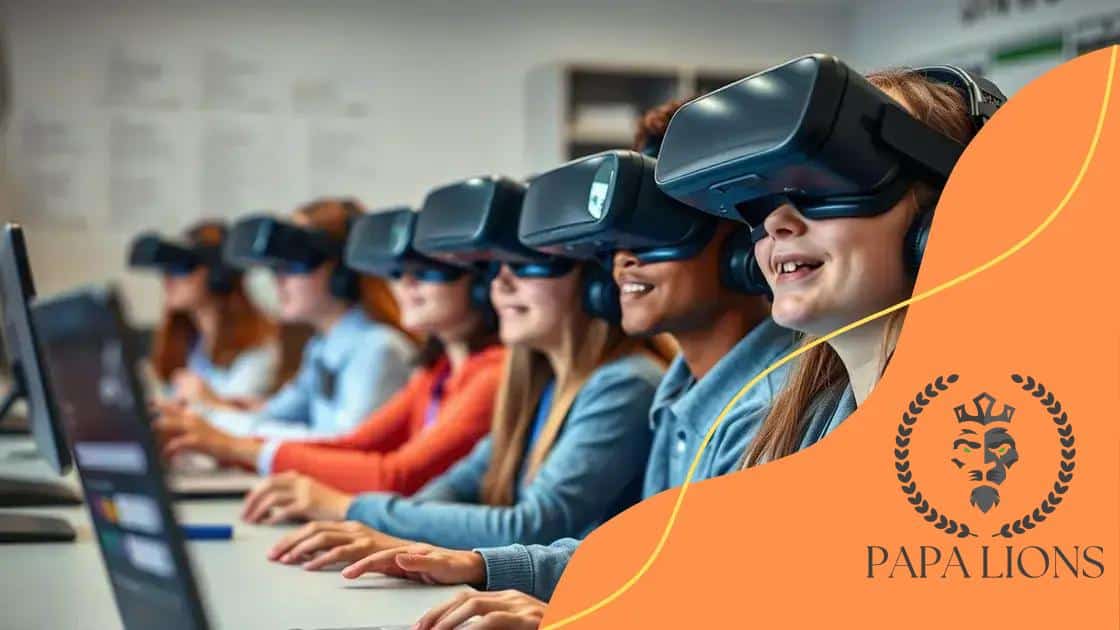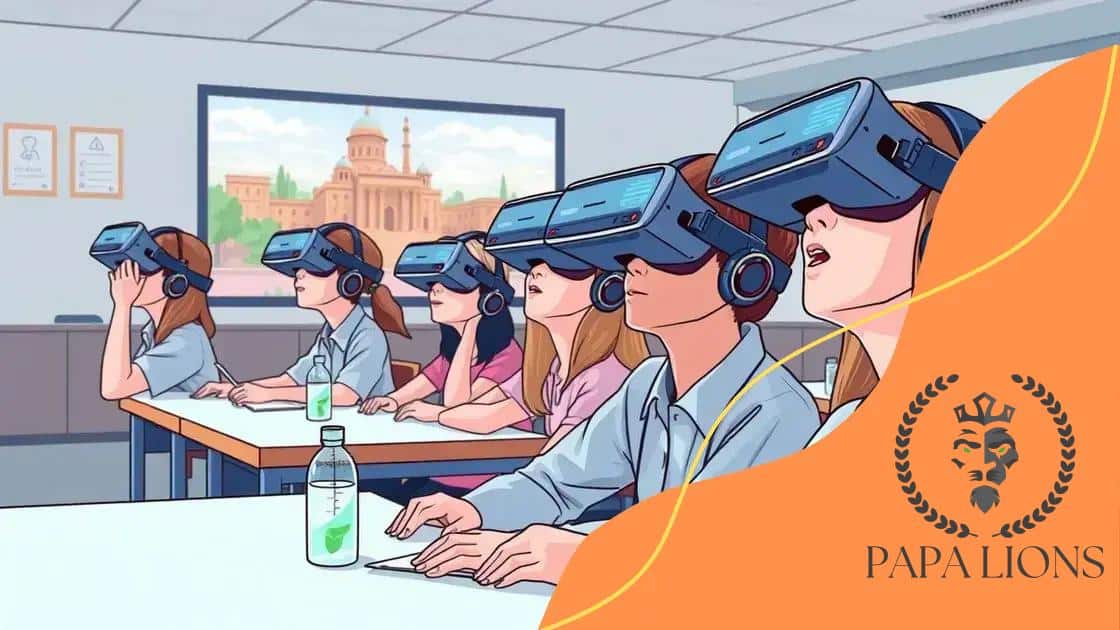Virtual reality in STEM education: a game changer

Virtual reality in STEM education enhances student engagement and understanding by providing immersive learning experiences, despite challenges like cost and the need for proper training.
Virtual reality in STEM education is transforming the learning landscape, offering students hands-on experiences that textbooks alone cannot provide. Imagine exploring the depths of the ocean or walking on Mars right from the classroom. Intrigued? Let’s dive into this exciting topic.
Understanding virtual reality in education
Understanding virtual reality in education is crucial for embracing new learning methods. This innovative approach transforms traditional classrooms into dynamic environments that enhance student engagement and comprehension. With virtual reality, students can experience lessons firsthand, which significantly enriches their understanding of complex subjects.
How Virtual Reality Works in Education
Virtual reality provides immersive experiences. By wearing headsets, students can explore simulations of real-world environments. This hands-on experience makes learning more effective. For instance, in a biology class, students can dive into a 3D representation of the human body, observing systems and organs interactively.
Benefits of Virtual Reality in the Classroom
- Enhanced Engagement: Students are more likely to pay attention and participate when they can interact with the material.
- Real-World Applications: Virtual reality allows students to engage with real-world scenarios relevant to their studies.
- Diverse Learning Styles: It caters to various learning preferences, appealing to visual, auditory, and kinesthetic learners.
- Safe Learning Environment: Students can experiment and make mistakes in a virtual space without real-life consequences.
Additionally, virtual reality encourages collaboration among students. They can work together on projects in a shared space, despite being physically apart. This aspect can foster teamwork and communication skills, both of which are vital in today’s world.
By integrating virtual reality into the curriculum, educators create a more inclusive and engaging learning atmosphere. It allows them to cater to every student’s needs effectively, paving the way for a better educational experience.
Benefits of virtual reality in STEM learning
The benefits of virtual reality in STEM learning are numerous and compelling. By implementing this innovative technology, educators can create immersive experiences that captivate students’ interest. The ability to dive into complex simulations and visualizations transforms how students engage with subjects like science, technology, engineering, and math.
Enhanced Engagement and Motivation
Students often feel more motivated when lessons involve virtual reality. By exploring simulations, they become active participants in their learning process. This increased engagement leads to a deeper understanding of concepts. For example, rather than reading about the solar system, students can experience it. They can fly through space, navigating from planet to planet and recognizing the distances and sizes in a much more personal way.
Improved Retention of Knowledge
Learning through virtual reality can help improve knowledge retention. Studies show that immersive experiences lead to better memory formation. When students interact with 3D models, they can better grasp abstract concepts, making it easier to recall information later. This hands-on learning positively influences their overall performance in STEM subjects.
- Safe Exploration: Students can experiment in a controlled environment without fear of failure.
- Customized Learning: VR experiences can be tailored to meet different learning paces and styles.
- Collaboration Opportunities: VR encourages teamwork, allowing students to work together in simulations.
Furthermore, virtual reality fosters creativity. By allowing students to visualize complex data and concepts, it opens the door to innovative thinking. They can manipulate variables in real-time scenarios, leading to an exploration of possibilities that are often limited in traditional settings. This opportunity encourages students to think outside the box and develop problem-solving skills essential for their future careers.
The integration of virtual reality tools prepares students for the modern workforce. With technology evolving rapidly, familiarity with VR systems equips them with valuable skills. As industries increasingly adopt virtual reality technologies, students trained in these environments will have an advantage, ensuring they are workforce-ready.
Practical applications of virtual reality in classrooms

The practical applications of virtual reality in classrooms are transforming traditional teaching methods. By incorporating virtual reality, educators can create immersive lessons that take students beyond textbooks. For example, in a history class, students can virtually visit ancient civilizations, experiencing culture and events first-hand.
Hands-On Learning Experiences
One of the most significant advantages of using virtual reality is the hands-on learning it offers. Students can interact with 3D models of anatomy in biology classes, exploring the human body in detail. In physics, they can simulate experiments without the risks associated with real-life setups. This approach enhances learning by making abstract concepts concrete and understandable.
Field Trips without Leaving the Classroom
Virtual reality also allows for field trips without the cost and logistical challenges. Students can explore the Great Barrier Reef or the surface of Mars from their desks. Such experiences can spark curiosity and inspire students to learn more about the world around them. They can immerse themselves in different environments and cultures effortlessly.
- Interactive Simulations: Students can participate in simulations that require them to make decisions based on real-world scenarios.
- Collaborative Projects: Virtual reality fosters collaboration, enabling students to work together on projects, even if they are in different locations.
- Enhanced Visual Learning: Complex ideas become easier to grasp through visual representations, making lessons more engaging.
Using virtual reality is not just entertaining; it also improves educational outcomes. Students often retain information better when they engage deeply with the content. Engagement levels increase as they become active participants in their education rather than passive listeners. The power of virtual reality lies in its ability to create memorable learning moments that resonate with students long after the lesson ends.
In subjects like chemistry, students can visualize molecular structures, aiding their understanding of reactions and bonding. This interactive learning approach encourages critical thinking and problem-solving skills. As educators adopt virtual reality technologies, they set the stage for more engaging, effective learning experiences.
Challenges of implementing virtual reality in schools
The challenges of implementing virtual reality in schools are significant, yet they offer opportunities for growth and learning. While virtual reality presents exciting prospects for education, there are obstacles that schools must navigate to integrate it effectively. Understanding these challenges is the first step towards overcoming them.
Cost of Technology
One major challenge is the cost associated with acquiring virtual reality hardware and software. Many schools operate on tight budgets, making it difficult to allocate funds for expensive equipment. Additionally, ongoing maintenance and updates can add to the expenses. Therefore, administrators need to consider how to budget for these technologies and find funding opportunities that can help.
Teacher Training and Support
Another significant hurdle is the need for teacher training. Educators must be adequately trained to use virtual reality tools effectively. This includes knowing how to integrate VR into lesson plans and understanding the technology itself. Lack of training can lead to frustration and ineffective use of VR, which can deter teachers from embracing this innovative approach to learning.
- Technology Integration: It’s essential for teachers to understand how to use VR alongside existing curricula.
- Professional Development: Schools may need to invest in workshops or training sessions to ensure teachers feel confident using VR.
- Peer Support: Creating a support network among teachers can help ease the transition into using new technologies.
Additionally, not all students may have equal access to virtual reality experiences. Issues such as accessibility and equity can arise. Some students may have devices or internet access at home, while others do not. This disparity can create an uneven playing field, making it crucial for schools to address these concerns and find ways to ensure all students can benefit from VR.
Finally, there are concerns regarding content appropriateness and safety. Educators must carefully evaluate the VR content used in classrooms to ensure it is suitable for students. Furthermore, safety and health concerns, such as motion sickness or eye strain, may arise with prolonged use of VR headsets. Establishing guidelines around safe usage is essential to protect students while maximizing learning opportunities.
Future of virtual reality in STEM education
The future of virtual reality in STEM education looks promising and full of potential. As technology continues to advance, educators are finding new ways to incorporate virtual reality into their classrooms. This innovation will likely become an essential tool for teaching and learning across various subjects.
Increased Accessibility
One key aspect of the future is the increased accessibility of virtual reality tools. As prices for VR hardware decrease and more affordable options emerge, schools will be better equipped to bring this technology to students. This accessibility enables all students to experience immersive learning, enhancing their education.
Advancements in Content Quality
In addition to hardware improvements, the quality of VR content is also expected to improve significantly. As educators, developers, and content creators collaborate, engaging and meaningful learning experiences will be available. These developments will allow students to explore complex STEM concepts through interactive simulations, making learning more exciting.
- Enhanced Collaboration: VR will foster collaboration among students, enabling them to work together in virtual environments, even if they are physically apart.
- Customized Learning Experiences: Personalized learning experiences will become more common, allowing students to learn at their own pace and skill level.
- Integration with Other Technologies: VR will likely be combined with AI and augmented reality, creating a multi-faceted learning experience for students.
The role of teachers will also evolve with the integration of virtual reality. Educators will become facilitators, guiding students through immersive experiences and helping them develop critical thinking skills. This shift in teaching methods will encourage students to take ownership of their learning, fostering independence and creativity.
Furthermore, as more industries adopt virtual reality technologies, students familiar with these tools will gain valuable skills for the workforce. By integrating VR into STEM education, schools will better prepare students for future careers in technology and science, where these skills will be essential.
Conclusion:
In summary, the integration of virtual reality in STEM education offers exciting opportunities for engaging and effective learning. Despite challenges like cost and training, the future looks bright as technology evolves. By embracing virtual reality, educators can create immersive experiences that enhance understanding and retention. This innovative approach prepares students for a dynamic workforce, equipping them with essential skills for future success.
FAQ – Frequently Asked Questions about Virtual Reality in STEM Education
What are the main benefits of virtual reality in STEM education?
Virtual reality enhances engagement and retention, allowing students to experience concepts in immersive environments.
What challenges do schools face in implementing virtual reality?
Challenges include cost, teacher training, and ensuring equal access for all students.
How does virtual reality prepare students for future careers?
By using VR, students develop critical skills in technology and problem-solving, which are valuable in many careers.
What does the future hold for virtual reality in education?
The future includes improved accessibility, better content quality, and enhanced collaboration among students.





